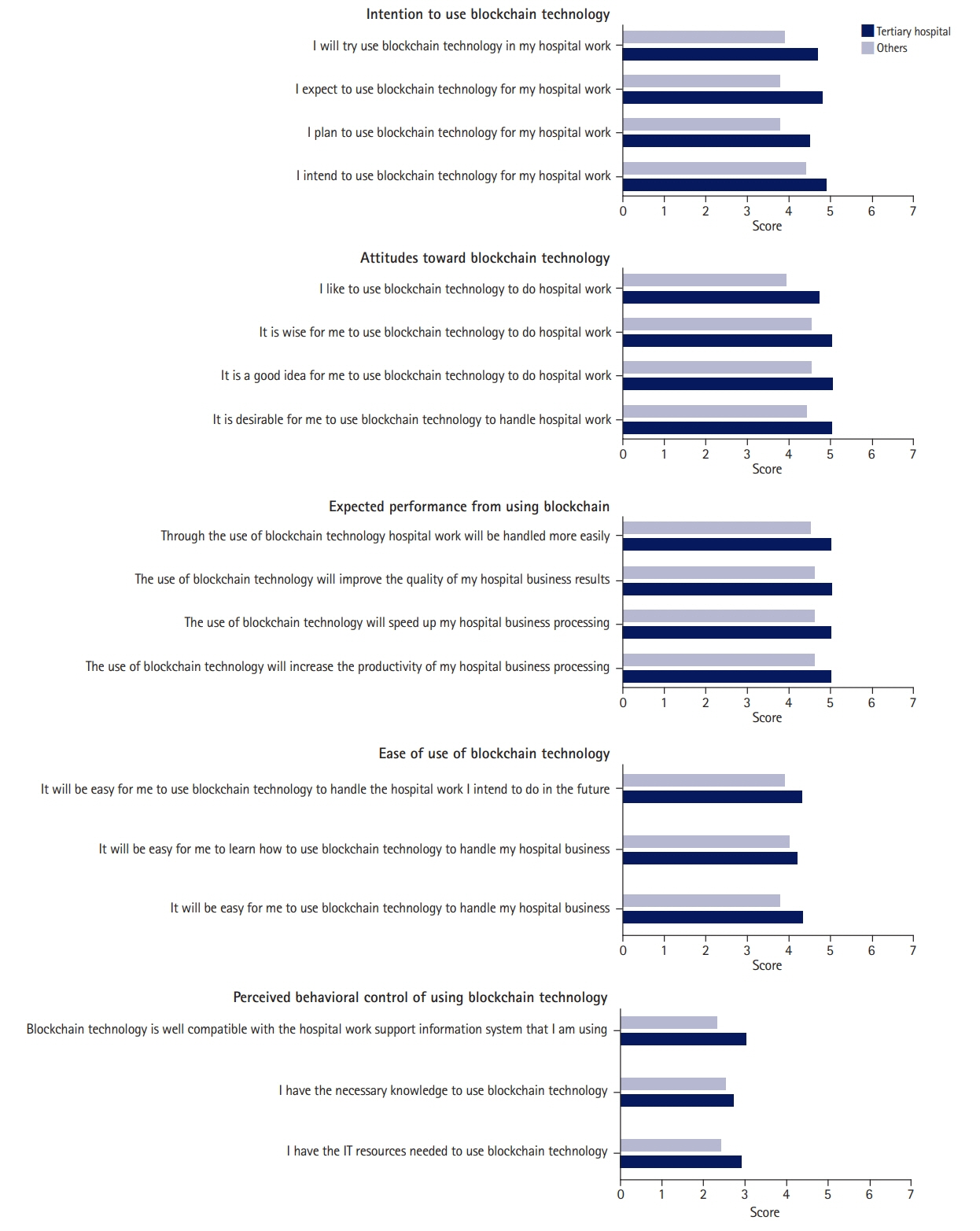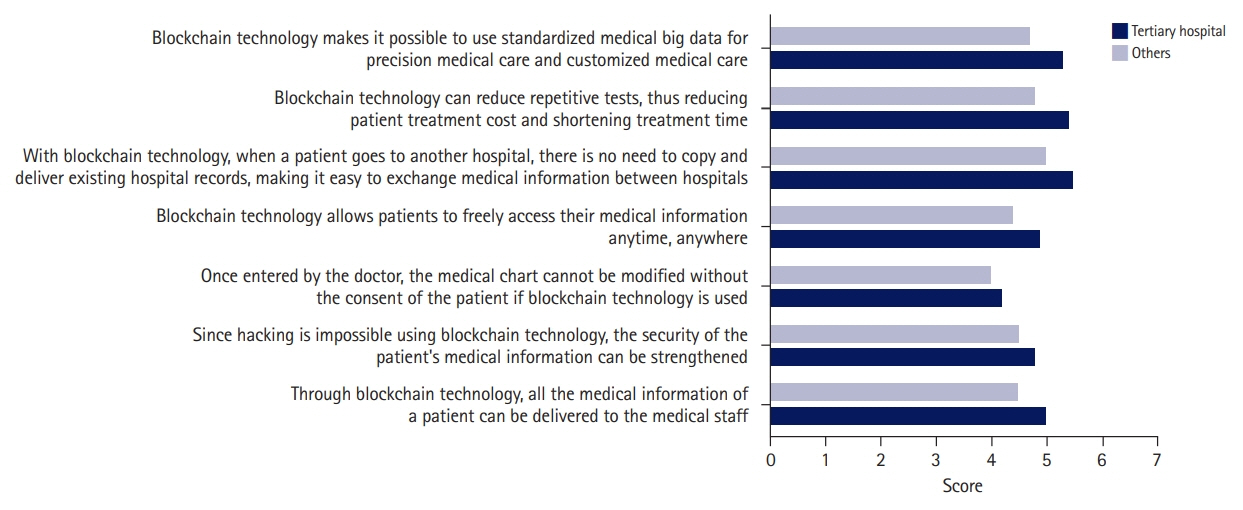J Yeungnam Med Sci.
2023 Apr;40(2):156-163. 10.12701/jyms.2022.00241.
Pediatricians’ perception of factors concerning the clinical application of blockchain technology to pediatric health care: a questionnaire survey
- Affiliations
-
- 1Department of Business Administration, School of Business, Yeungnam University, Gyeongsan, Korea
- 2Medical Management Research Center, Yeungnam University, Gyeongsan, Korea
- 3Department of Physical Medicine and Rehabilitation, Yeungnam University College of Medicine, Daegu, Korea
- 4National Information Society Agency, Daegu, Korea
- 5Department of Pediatrics, Yeungnam University College of Medicine, Daegu, Korea
- KMID: 2541941
- DOI: http://doi.org/10.12701/jyms.2022.00241
Abstract
- Background
Interest in digital medical information has increased because it allows doctors to easily access a patient’s medical records and provide appropriate medical care. Blockchain technology ensures data safety, reliability, integrity, and transparency by distributing medical data to all users over a peer-to-peer network. This study attempted to assess pediatricians’ thoughts and attitudes toward introducing blockchain technology into the medical field.
Methods
This study used a questionnaire survey to examine the thoughts and attitudes of 30- to 60-year-old pediatricians regarding the introduction of blockchain technology into the medical field. Responses to each item were recorded on a scale ranging from 1 (never agree) to 7 (completely agree).
Results
The scores for the intentions and expectations of using blockchain technology were 4.0 to 4.6. Pediatricians from tertiary hospitals responded more positively (4.5–4.9) to the idea of using blockchain technology for hospital work relative to the general population (4.3–4.7). However, pediatricians working in primary and secondary hospitals had a slightly negative view of the application of blockchain technology to hospital work (p=0.018).
Conclusion
When introducing the medical records of related pediatric and adolescent patients using blockchain technology in the future, it would be better to conduct a pilot project that prioritizes pediatricians in tertiary hospitals. The cost, policy, and market participants’ perceptions are essential factors to consider when introducing technology in the medical field.
Figure
Reference
-
References
1. Jiang S, Cao J, Wu H, Yang Y, Ma M, He J. BlocHIE: a blockchain-based platform for healthcare information exchange [Internet]. In: Institute of Electrical and Electronics Engineers (IEEE). Proceedings of 2018 IEEE International Conference on Smart Computing, SMARTCOMP 2018. Taormina, Italy: IEEE Inc;2018. [cited 2022 Mar 31]. https://doi.org/10.1109/SMARTCOMP.2018.00073.2. Hau YS, Lee JM, Park J, Chang MC. Attitudes toward blockchain technology in managing medical information: survey study. J Med Internet Res. 2019; 21:e15870.3. Radanović I, Likić R. Opportunities for use of blockchain technology in medicine. Appl Health Econ Health Policy. 2018; 16:583–90.4. Bashir I. Mastering blockchain: distributed ledger technology, decentralization and smart contracts explained. 2nd ed. Birmingham: Packt Publishing;2018.5. Krawiec RJ, Housman D, White M, Filipova M, Quarre F, Barr D, et al. Blockchain: opportunities for health care [Internet]. New York: Deloitte;2016. [cited 2022 Mar 31]. https://www2.deloitte.com/content/dam/Deloitte/us/Documents/public-sector/us-blockchain-opportunities-for-health-care.pdf.6. Kho W. Blockchain revolution in healthcare: the era of patient-centered dental information system. Int J Oral Biol. 2018; 43:1–3.7. Pirtle C, Ehrenfeld J. Blockchain for healthcare: the next generation of medical records? J Med Syst. 2018; 42:172.8. Cichosz SL, Stausholm MN, Kronborg T, Vestergaard P, Hejlesen O. How to use blockchain for diabetes health care data and access management: an operational concept. J Diabetes Sci Technol. 2019; 13:248–53.9. Tung JK, Nambudiri VE. Beyond Bitcoin: potential applications of blockchain technology in dermatology. Br J Dermatol. 2018; 179:1013–4.10. Chang MC, Hau YS, Park JC, Lee JM. The application of blockchain technology in stroke rehabilitation. Am J Phys Med Rehabil. 2019; 98:e74.11. Davis FD. Perceived usefulness, perceived ease of use, and user acceptance of information technology. MIS Quarterly. 1989; 13:319–40.12. Ajzen I. The theory of planned behavior. Organ Behav Hum Decis Process. 1991; 50:179–211.13. Mediblock. [MediBloc] Reinventing the medical experience [Internet]. Seoul: Mediblock;2018. [cited 2022 Mar 31]. https://youtu.be/c4MUhQ_KfAw.14. Venkatesh V, Morris MG, Davis GB, Davis FD. User acceptance of information technology: toward a unified view. Mis Quarterly. 2003; 27:425–78.15. Min D, Kim JH. Is power powerful? Power, confidence, and goal pursuit. Int Res J Mark. 2013; 30:265–75.16. Choi HJ. Application of blockchain in the healthcare industry. KHIDI Brief. 2017; 236:1–26.17. Kim H, Park S, Ahn Y. Clinical research networks for rare diseases. PHWR. 2018; 11:34–8.18. Champoux JE. Organizational behavior integrating individuals, groups, and organizations. 4th ed. New York: Routledge;2010.19. Vroom VH. Work and motivation. San Francisco: Jossey-Bass Publishers;1995.20. Kaufman L, Holland J, Weinberg S, Rosenbloom ST. Medical record keeping in the summer camp setting. Appl Clin Inform. 2016; 7:1154–67.21. Choi EH, Park SE, Kim YJ, Jo DS, Kim YK, Eun BW, et al. Recommended immunization schedule for children and adolescents: Committee on Infectious Diseases of the Korean Pediatric Society, 2018. Korean J Pediatr. 2019; 62:252–6.22. Kim C, Park O, Kim M, Kim M, Lee S, Jung H. A study on registration data analysis of national immunization registry information system. J Korea Inst Inf Commun Eng. 2015; 19:1151–6.23. Mann DM, Chen J, Chunara R, Testa PA, Nov O. COVID-19 transforms health care through telemedicine: evidence from the field. J Am Med Inform Assoc. 2020; 27:1132–5.
- Full Text Links
- Actions
-
Cited
- CITED
-
- Close
- Share
- Similar articles
-
- Blockchain Revolution in Healthcare : The Era of Patient-centered Dental Information System
- Pediatricians’ perspectives on telemedicine for pediatric patients
- Blockchain: An Overview and Its Applications in Aviation
- Blockchain Applications for Healthcare Data Management
- Massive Closures of Pediatric Clinics and an Exodus of Pediatricians in Korea During the COVID-19 Pandemic: What Career Paths Did Closed-Down Pediatricians Choose?



